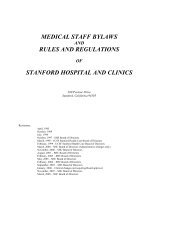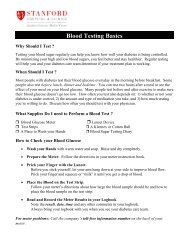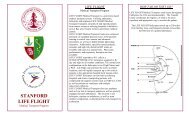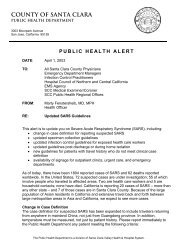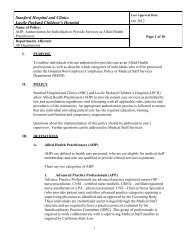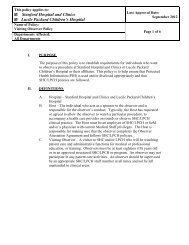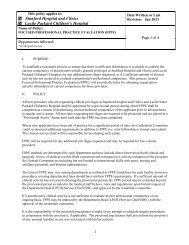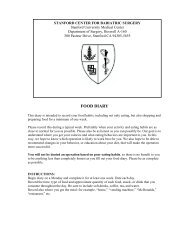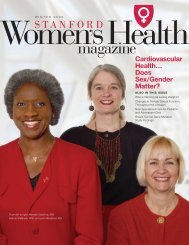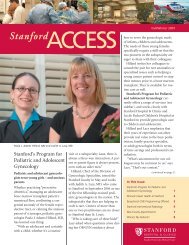rEdEFInIng - Stanford Hospital & Clinics
rEdEFInIng - Stanford Hospital & Clinics
rEdEFInIng - Stanford Hospital & Clinics
You also want an ePaper? Increase the reach of your titles
YUMPU automatically turns print PDFs into web optimized ePapers that Google loves.
Dr. Kevin Tabb<br />
Chief Medical Officer<br />
<strong>Stanford</strong> <strong>Hospital</strong> & <strong>Clinics</strong><br />
AdvAncIng<br />
RECOGNITION FOR STANFORD HOSPITAL & CLINICS<br />
U.S. News & World Report<br />
U.S. News & World Report has ranked us the #1 hospital<br />
in San Jose, California, in its first-ever Best <strong>Hospital</strong>s Metro<br />
Area rankings.<br />
leapfrog group<br />
Our top hospital designation from the leapfrog group recognizes<br />
our accomplishments in preventing medication errors, exceeding<br />
standards for high-risk procedures and increasing patient safety.<br />
A nEW ErA In mEdIcInE<br />
technology<br />
and<br />
innov<br />
As our nation’s focus on the exciting potential for electronic medical records to advance<br />
health care continues, <strong>Stanford</strong> <strong>Hospital</strong> & <strong>Clinics</strong> is proud to be at the forefront of this<br />
new era in medicine. last year, we became one of a handful of institutions nationwide<br />
to receive the highest-level designation for our electronic medical record system. This<br />
year we began to explore how having this capability will improve patient outcomes,<br />
increase safety and help manage costs.<br />
We now have the tools to actually do what in the past could only have been imagined.<br />
Within each patient’s electronic medical record is a treasure trove of information. When<br />
combined with similar information about thousands of other individuals, it will provide<br />
us with insights about how to deliver better care and ensure that resources are being<br />
used effectively and efficiently.<br />
Our challenge is to turn this invaluable data into meaningful information. until now,<br />
patient data was in millions of pages of paper files, inaccessible on an aggregate<br />
basis to researchers. <strong>Stanford</strong> is uniquely positioned to lead the new era of discovery<br />
made possible by electronic data, drawing upon the expertise of our physician faculty<br />
at the <strong>Stanford</strong> School of Medicine, our innovation partners in Silicon Valley and the<br />
unmatched interdisciplinary resources of <strong>Stanford</strong> university.<br />
We know, for example, that it is important to follow clinical guidelines in health care,<br />
yet it is a challenge for hospitals everywhere to take national guidelines and use them<br />
consistently to improve care. By analyzing the extensive data in electronic medical<br />
records, we will be able to determine with much greater clarity where we are doing<br />
well, where we need to do better and where to make necessary changes rapidly.<br />
Never before in the history of medicine has this been possible, and <strong>Stanford</strong> <strong>Hospital</strong><br />
is one of only a few institutions that will be doing this soon.<br />
The quality of care we provide to our patients is already at the highest level—as evident<br />
in the awards and recognition that <strong>Stanford</strong> <strong>Hospital</strong> & <strong>Clinics</strong> continues to receive<br />
from the leapfrog <strong>Hospital</strong> Survey, the American Nurses Credentialing Center Magnet<br />
designation, U.S. News & World Report and many others. Today we are poised to reach<br />
even higher goals on behalf of our patients and to achieve the full potential of electronic<br />
medical records for patients here and around the world.<br />
American Nurses Credentialing Center<br />
We are among only 6 percent of all healthcare organizations in<br />
the u.S. to achieve the ANCC Magnet Recognition ® status based<br />
on quality patient care, nursing excellence and innovations in<br />
professional nursing practice.<br />
Healthcare Information and Management Systems Society<br />
We received the highest level designation for our electronic medical<br />
record system from the leading healthcare IT industry group, HIMSS.<br />
<strong>Stanford</strong> <strong>Hospital</strong> was the fourth healthcare organization in the nation<br />
to achieve top-level designation, known as “Stage 7.”<br />
ation<br />
TO AcHIEvE THE<br />
HIgHEsT-QUALITY cArE<br />
YOUr mEdIcAL InFOrmATIOn<br />
AT YOUr FIngErTIPs<br />
In December 2010, <strong>Stanford</strong> <strong>Hospital</strong> & <strong>Clinics</strong> launched<br />
MyHealth, a tool that helps patients and their physicians<br />
make digital health records a more useful part of everyday<br />
care. “We were looking for a tool that would help patients<br />
interact with us in a meaningful way,” says Dr. Christopher<br />
Sharp, an internist and lead physician advocate for the<br />
MyHealth system.<br />
The Web-based system enhances the doctor-patient<br />
relationship by increasing access to clinics and providing<br />
timely, secure information about a patient’s medical care.<br />
using MyHealth, <strong>Stanford</strong> patients can see health information<br />
such as test results, keep track of upcoming appointments<br />
and send secure messages to their clinics if they have<br />
questions or concerns. In its first month, more than 2,300<br />
messages were sent to clinics, and more than 16,000 patients<br />
have taken advantage of the program so far.<br />
Room 9: A nEW sTAgE FOr<br />
HYBrId HEALTH cArE<br />
It used to be standard operating procedure for a neurosurgery patient to<br />
travel quite a distance inside the hospital. Diagnostic imaging, microscopic<br />
monitoring and surgical interventions were not in one place, requiring full<br />
operating teams, as well as their patients, to move from room to room.<br />
That was before Room 9.<br />
Designed specifically to allow on-scene collaboration between specialists<br />
in neurosurgery and neuroradiology, Room 9 is 800 square feet of hybrid<br />
capability. It is large enough to house state-of-the-art imaging equipment,<br />
space for surgery and room to accommodate any extra medical professionals<br />
who might be needed in an unanticipated turn of events. In Room 9, daylong<br />
neurological procedures have been reduced to only four hours, and patients<br />
face fewer risks from movement and less exposure to radiation for imaging.<br />
Building on the success of Room 9, the New <strong>Stanford</strong> <strong>Hospital</strong> will include<br />
one entire floor of this kind of multipurpose space, with several 1,000-squarefoot<br />
units large enough to accommodate larger-scale equipment and more<br />
people. “We are convinced that new hybrid rooms are what is needed at<br />
<strong>Stanford</strong>, so it makes sense to invest the effort and funds to make it happen,”<br />
says Jerry Maki, the <strong>Hospital</strong>’s Vice President of Clinical Services.<br />
14 Return to TOC<br />
15




